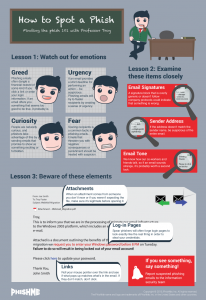The Dangers of Phishing – Tips on Identification of Phishing Emails
Tips for identification of phishing emails:
- Spoofed Emails – Looking at the sender’s address is important. Phishers impersonate the first and last name, but are unable to send from your domain (unless the account has already been compromised) if it is set properly.
- Wire transfers/Receipt of Payment – Any email asking for money or stating money was received and wants a confirmation is suspicious and should be treated carefully.
- Attachments – Any attachment from a sender that you haven’t asked for should be treated carefully. PDF/Word Documents are common offenders.
- Too many links in the email – Links, especially those that are truncated, suck as bit.ly links, should be treated as suspicious. Often times these bring you to a website that asks for your credentials and is made (often poorly) to look like a legitimate source.




